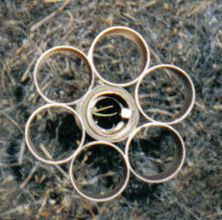Centuri Groove Tube
Centuri - Groove Tube {Kit} (5011, KA-11) [1972-1981]
Contributed by Jay Goemmer
| Construction Rating: | starstarstarstarstar |
| Flight Rating: | starstarstarstarstar |
| Overall Rating: | starstarstarstarstar |
| Manufacturer: | Centuri |
| Style: | Futuristic/Exotic |

Brief:
Decades before Quest Aerospace's "Totally Tubular," Custom Rockets'
"Razor," and the now-defunct Rogue Aerospace's "Hex
Courier," the Centuri "Groove Tube" was my first encounter with
a 6-pack of tube fins. I enjoyed this kit while I was flying model rockets
"back in the day" during the 1970's and found myself quite surprised
(but well pleased) with its performance in the 21st century.
Construction:
Parts list:
- BT-50 Body Tube, 13.5" L
- 6 BT-50 Body Tubes, 3" L
- PNC-50YR, 4.125" L
- 12" parachute (Recovery Technologies "Master" by Deby Falkner)
- EM-2050 Engine Mount
- EH-2 Engine Hook
- 100 lb. Kevlar® Thread, 14" L
- Elastic Cord, 1/8" W, 36" L
- Snap Swivel (for parachute)
I followed the instructions downloaded from JimZ, but since I didn't have any Centuri PNC-89 nose cones to spare, I decided to upscale the Groove Tube from a Centuri ST-8 body tube (0.908" diameter) to an Estes BT-50 (0.976" diameter). I also extended the body tube length slightly (half an inch) to compensate for the somewhat shorter Estes nose cone. I ended up with a roughly 1.07X Groove Tube upscale, although I didn't scale up the length of the tube fins at all.
When marking the length of your tube fins, I'd recommend cutting just one and using it as a marking guide for the other 5 shorter tubes. If you cut carefully and precisely, all of your tube fins should be very close to the same length. Glue the 6 tube fins into 3 pairs first, making sure to align them carefully.
I used the now standard Kevlar®/elastic shock cord mount, tying the Kevlar® around the forward CR-2050 centering ring. Incidentally, wood glue (aliphatic resin) is ideal for building this rocket. Insert the EM-2050 engine mount (assembled with engine hook) with 3/4" protruding from the aft end of the BT-50 main body tube.
 One by
one, glue the pairs of tube fins onto the main BT-50 tube, placing the engine
hook between the tubes of the first pair. (The slightly larger difference in
sizes between the Estes BT-20 and BT-50, in contrast to the Centuri ST-7 and
ST-8, allows for better clearance for the engine hook.) The hard part is lining
up the aft end of the tube fins with the corresponding end of the BT-20 engine
mount tube. Let dry for 24 hours before installing the next pair of tube fins.
Then allow another day to dry, and you can install the third pair of
"fins." I'd recommend waiting an additional 24 hours before painting.
One by
one, glue the pairs of tube fins onto the main BT-50 tube, placing the engine
hook between the tubes of the first pair. (The slightly larger difference in
sizes between the Estes BT-20 and BT-50, in contrast to the Centuri ST-7 and
ST-8, allows for better clearance for the engine hook.) The hard part is lining
up the aft end of the tube fins with the corresponding end of the BT-20 engine
mount tube. Let dry for 24 hours before installing the next pair of tube fins.
Then allow another day to dry, and you can install the third pair of
"fins." I'd recommend waiting an additional 24 hours before painting.
Finishing:
When I built this version of the Groove Tube, I hadn't stumbled across my
"2 coats of primer, sand after each coat" method of prepping the body
tubes yet. And because I was in a hurry to paint this rocket the night before
flying it, I applied a quick and dirty (and runny, in some places) coat of
Krylon gloss orange paint. I figured an orange rocket would provide more
contrast than a white one would. If I hadn't been in such a hurry, I would have
applied flat black paint to the interior of the tube fins to add a slight
coolness factor to the finish.
Construction Rating: 5 out of 5

Flight:
My Groove Tube's maiden flight was at Tripoli Idaho's summer flight range near
Fairfield, Idaho on an A8-3 motor. The parachute ejected at an apogee of about
400 feet. Even though the altitude wasn't very high, this rocket turned out to
be a real crowd pleaser since everybody could see the complete flight profile.
The Groove Tube landed just 10 feet from the Launch Control Officer
(LCO)--almost too close!
Just before the second flight, a 25 mph gust of wind blew over the launch rack, partially crushing the tube fins on the Groove Tube.
After setting the the launch rack upright and reattaching the alligator clips to the igniter, the Groove Tube turned in another picture-perfect flight on a B6-4, reaching an altitude of about 600 feet. Ejection was right at apogee again, and I got the most compliments of the day with this flight.
Amazed that this rocket was proving to be an incredible flyer, I shoved in a C6-5 motor and was rewarded with another excellent flight to about 800 feet. I'd like to see how a Semroc SLS-size Groove Tube upscale with a 24mm engine mount performs on C11 and D12 motors--heck, even on an E9!

Recovery:
PROs: A solid design and a sure crowd pleaser.
CONs: A little draggy but it flies like a dream.
Flight Rating: 5 out of 5
Summary:
PROs: No balsa fins (or nose cone) to fill and finish, and while it's not the
only tube fin design on the market, I highly recommend this rocket...in any
size!
CONs: Accurately cutting and attaching tube fins is slightly difficult but an easy build for even a semi-experienced rocketeer.
Overall Rating: 5 out of 5
 |
 |
 |
 |
Bill Eichelberger (September 23, 2021)
What, no love for the Custom Serval?